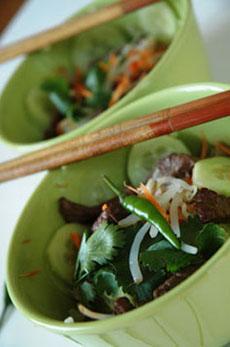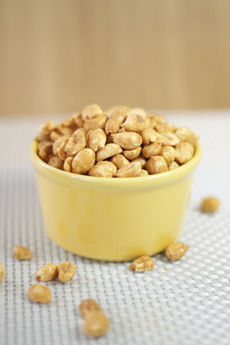TIP OF THE DAY: Ways To Use Peanuts
|
While some people are allergic to them, there are enough peanut lovers to make this “nut” (it’s actually a legume) the overwhelming nut of choice in America.
Although peanut butter makes up a large percentage, 67% of American nut consumption comprises peanuts. Almonds are second at 13%, with the remainder filled out by pecans (4%), pistachios and almonds (each 2%) and other tree nuts (12%). Yet, the grand winner in the nut category is not an actual nut, but a legume—a botanical group that includes alfalfa, beans, carob, clover, lentils, mesquite, peas, soybeans and climbing vines like wisteria. Peanuts actually grow underground,* as opposed to true nuts, which grow on trees (and in recent times have engendered the differentiating term, “tree nuts”). Tree nuts are packed with protein and other excellent nutrition; legumes, as a group, provide the best source of concentrated protein in the plant kingdom. Today’s tip covers ways to use this nutritious nut/legume in cooking. |
|
|
|
TYPES OF PEANUTS There are four categories of peanuts; if you taste them side-by-side, you’ll notice subtle flavor differences. |
||
 Thai beef salad. Photo by Nathalie Dulex | Fotolia. |
WAYS TO USE PEANUTS
There’s a world of peanut-liciousness beyond peanut butter, which is terrific in baked goods, sauces, and delicious peanut soup (try these peanut soup recipes). Many Asian cuisines add nuts to cooked dishes, from curries to stir frys. |
|
|
THAI BEEF SALAD WITH SPICY PEANUT DRESSING Ingredients For Dressing 1. WHISK together all the dressing ingredients except peanuts. Stir in peanuts just before mixing with salad. 2. COMBINE the beef, cucumbers, snow peas, bean sprouts, peppers, cabbage and onions with dressing. 3. ARRANGE salad on lettuce leaves. Sprinkle with peanut garnish. Serve. A BRIEF PEANUT HISTORY Today, peanuts are grown in tropical and subtropical regions around the globe, but they most likely originated in South America. When the Conquistadors returned to Europe from Mexico in the early 1500s, peanuts went with them. Traders brought peanuts to Asia and Africa, and the versatile legume made its way to North America on sailing ships in the 1700s. Yet, peanuts were not grown extensively in America; harvesting techniques were slow and difficult. Until the Civil War, the peanut was a regional food in the southern U.S. (It’s the “goober” in the famous Civil War song, “Eating Goober Peas”; and why Nestlé calls its chocolate-covered peanuts Goobers.) After the Civil War, the demand for peanuts increased rapidly. According to PeanutsUSA.com, by the end of the 19th century, the development of equipment for production, harvesting and shelling peanuts, as well as processing techniques, led to the expansion of the peanut industry. Twentieth century labor-saving equipment resulted in a rapid demand for peanut oil, roasted and salted peanuts, peanut butter and confections.
|
||



